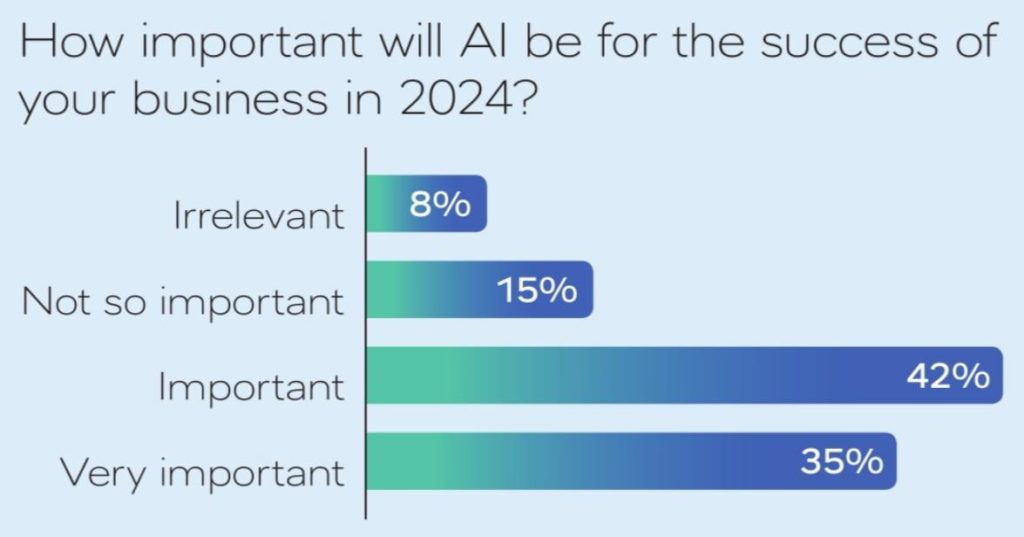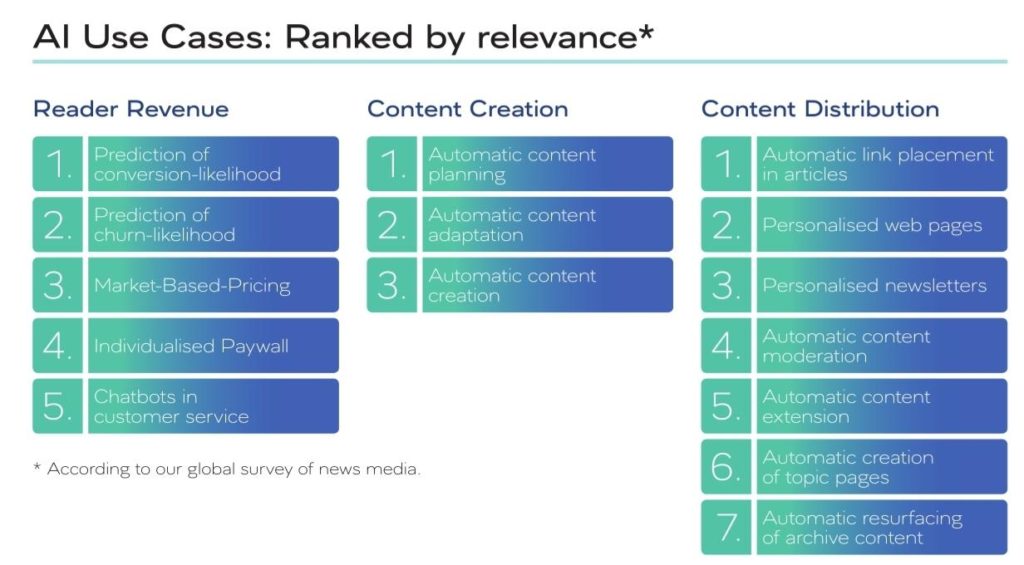|
Getting your Trinity Audio player ready...
|
“What is refreshing is this is not relegated to just publishers with deep pockets”
77% of publishers say AI will play a crucial role in the success of their business within the next three years, according to a new WAN-IFRA report, AI’s rising role with editing and reader revenue. 46% do not use AI at all at present, the remaining 54% are at various stages of experimentation/implementation.
Looking at “what’s next” possibilities
The report is based on a global survey of data specialists at news media operations, commercial executives, and editors. It focuses on how publishers are using or plan to use AI tools in editing and growing reader revenue.
The report includes case studies of news publishers who have implemented AI use cases such as dynamic paywall control, churn prediction modeling, automatic surfacing of archive content and automatic creation of soccer game reports.
What is refreshing is this is not relegated to just publishers with deep pockets, nor to the usual pioneers in the business. Small publishers all over the world are innovating, partnering, developing AI solutions for their companies.
Dean Roper, Director of Insights, WAN-IFRA
These cases “highlight not only the effectiveness of AI adoption but also its potential as most are looking at “what’s next” possibilities and developing projects and tools,” adds Roper.
“Data-driven customer journey”
“Reader revenue might be the most natural fit for news publishers to apply AI use cases,” the authors write. “The customer base is typically large, hence big datasets from customers can be collected, and automating processes in an intelligent manner creates huge leverage.”
Among the five most commonly applied AI use cases currently, predictions of churn- and conversion-likelihood was cited as being most important. Over 90% of the respondents plan to implement them by 2024.
Belgium-based Mediahuis is aiming to implement a fully automated data-driven customer journey. “The main question among all our entities at least from a data science and business perspective,” says Jessica Bulthé, Data Science Business Partner at Mediahuis, “is how do you acquire new subscribers, keep current subscribers happy, and retain those subscribers, while doing this in the most efficient, personalized manner. The answer? A data-driven customer journey.”
The publisher uses a churn propensity prediction model developed in-house to target existing customers who seem likely to churn but are worthwhile to keep, and could be persuaded to stay on. The model is able to predict loyalty at an accuracy of 91%.
Mediahuis is now developing a propensity to buy model that will be able to predict whether someone will buy a subscription as well as the type of subscription they will buy in the next month. Bulthé says that the model has been able to correctly predict 8 out of 10 cases whether somebody will buy a subscription in the next month.
“51% increase in subscription conversions”
Toronto-based The Globe and Mail has developed “Sophi,” a suite of AI-based tools for paid content, automated content placement, and analytics. It includes a dynamic paywall that analyzes both reader behavior and content to “determine whom to show a paywall or registration wall, and whom to leave alone in order to maximize engagement with users with a low propensity to subscribe,” says Gordon Edall, VP, Sophi. The tool has triggered a 130% increase in registrations and a 51% increase in subscription conversions.
Another tool decides where to place 99% of all digital content across publisher’s properties. “It is able to effectively re-program hundreds of millions of promotion slots across all our pages to produce combinations of content that better help our audiences connect to our content,” adds Edall.
It has led to a 17% increase in CTR from the homepage and a 10% increase in subscriber acquisition rate. Earlier the publisher used to rely on advertising for 70% of its revenue. Reader revenue now accounts for 70% of revenue, while ads account for 30%.
News24, based in South Africa, launched a freemium paywall in August of 2020, putting about 20% of its content behind the subscription wall. The publisher used Sophi to rank news stories, prioritize publishing times, and get conversion predictions. It helped News24 garner 45,000 subscriptions in just over a year.
“Analytics are much smarter now than purely page views,” says Adrian Basson, Editor-in-chief of News24 in South Africa. “Analytics and specifically AI tools help us to convert casual readers into subscribers and actually build a reader revenue business that tacitly has helped to increase the size of our newsroom so we can create better journalism.”
“The key lies in collaboration”
“Any adoption of a new technology brings its own set of obstacles and challenges, and AI is certainly not an exception,” the authors write. The biggest challenges cited by publishers in the survey include lack of funding and time. These are followed by developing actual production-ready AI use cases, identifying promising use cases, and technically applying AI results to the business processes.
“The key lies in collaboration, both internally and externally,” suggest the authors. “Naturally, larger publishers might have in-house resources on their data teams to deploy AI tools, or they can hire those skill sets, or just work with an AI vendor more easily than a small publisher. But they should strongly consider tapping into a vast ecosystem of startups, labs and universities, and even other like-minded news publishers, to partner with.”
Regardless of the size, starting on one project that your operation can feasibly cope with but has a solid impact can lay the groundwork for successfully proving the worth of the tools, breeding confidence to both your newsroom and management.
AI’s rising role with editing and reader revenue
The full report can be downloaded from WAN-IFRA:
AI’s rising role with editing and reader revenue







